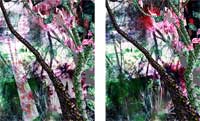Cynthia Beth Rubin
Hiding Spaces: A Cave of Elusive Immateriality
Daniel F. Keefe and Cynthia Beth Rubin
Hiding Spaces is an immersive VR Cave artwork which pushes past the limitations of physical media by exploring the new ambiguities that can delight the viewer in the virtual world. By using innovative tools developed especially for creative work within the Cave environment, in combination with more established digital methods and artistic practice, the authors collaborated to produce a work which transgresses the usual borders of 2D and 3D, including those that are common even in VR environments.
Engaging visual art depends on a rhythmic interplay of texture, color,and form to captivate the viewer and to create the sensation of movement. Many artists, particularly those working in static 2D media, employ these elements to create ambiguous spatial tensions. Artists love ambiguity, and 2D artists especially are enamored of spaces that are never defined but rather remain elusive, because spatial illusion is what makes traditional 2D imagery come alive.
In the Cave environment we have the opportunity to further the power of elusive space by incorporating the play of "real" space against the illusion of ambiguous space. In this work, the 2D spaces breathe not only because of the illusion of complex spatial relationships, but through the actual non-static nature of the projections. Rather than deny the limitations of the physical walls of the Cave, Hiding Spaces utilizes them as an integral part of the work.
Hiding Spaces is comprised of 2D painterly images in combination with virtual 3D objects, using software that runs in a 4-wall immersive virtual reality system (Cave).To experience the work, viewers wear stereo shutter glasses with a positional tracker. As the viewer moves around the space, the system detects each new position, thus triggering corresponding shifts in the imagery. While the 3D forms remain anchored at the walls, the 2D images, projected on the walls and door, slowly shift by means of a soft cross-fade.
The entire human-computer-interaction is based on the familiar and natural activities of walking and looking. The viewer is drawn to a 3D object or a spot of 2D imagery, but in moving towards it, finds that this very action prompts a change. When something else catches the viewerÕs attention, the cycle repeats. The user is constantly compelled to explore, yet does not have to learn any complex interaction modalities. By simply walking around and exploring naturally, the viewer quickly learns that it is engagement and curiosity that cause the imagery to shift , and this in turn encourages more interaction with the system.
Hiding Spaces evolved from photographic sources manipulated in Adobe Photoshop and Corel Painter, first used in an earlier 2D printed digital image (Old House in the Shadow of the Castle). As we discovered that projecting shifting images on walls was too jarring without slowly blending transitions, we developed a method for creating convincing digital color and texture in varying overlays. The proprietary software Cave-Painting * allowed us to create forms within the Cave itself in response to the imagery on the wall. As a result of our experiments with the juxtaposition of 2D and 3D elements in the Cave, we eventually developed textures for the 3D Cave-painted forms out of image fragments of the projected 2D images. *(see Keefe, D.,Acevedo, D.,Moscovich,T. ,Laidlaw,D., and LaViola, J.CavePainting: A Fully Immersive 3D Artistic Medium and Interactive Experience, Proceedings of the 2001 Symposium on Interactive 3D Graphics)

Thanks to the Brown University Graphics Group, Scientific Visualization Group, and the Technology Center for Advanced Scientific Computing and Visualization, and to David Laidlaw and Sean Solley for their insights in the development of this project. This work was partially supported by NSF (CCR-0086065, EIA-9871440).
Published: Proceeding SIGGRAPH '02 ACM SIGGRAPH 2002 conference abstracts and applications,
Pages 192-192 , ACM New York, NY, USA 2002
table of contents ISBN:1-58113-525-4 doi>10.1145/1242073.1242205
Presentations (artist lectures; actual work is dependent on VR CAVE)
2002 Artist Sketch SIGGRAPH San Antonio TX
2002 Artist poster session, ISEA, Nagoya, Japan
© 2002 (images and text ) Rubin//Keefe
Cynthia Beth Rubin ©2021